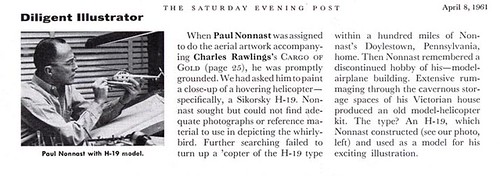
Though we don't have a b&w auto ad by Nonnast to look at, his description of the process he used sounds similar in some ways to the one described not long ago by Charlie Allen.
Says Nonnast, "[I] make a black-and-white line drawing, then take it to the engraver and have made what is called a line-film-positive - a heavy film of the drawing. Then very carefully trace such parts of the line drawing as will embrace half-tone areas. Transfer onto board this tracing - needle sharp. Paint in all half-tone areas in grays and flap-mount the above line-film-positive over this half-tone areas painting. The final picture can then be seen as it will appear, and the two parts of the picture can be combined by the engraver with a minimum of fitting and separating. By making this sort of separation they can use the line drawing and make color drawings instead of the half-tone gray, for use in Sunday colored supplement magazines."

Perhaps Nonnast used a similar process for all his more 'technical' looking art, like the space scene above.
Magazine editors favoured certain illustrators for certain types of work, and its not unusual to find Paul Nonnast illustrations that incorporate heavy machinery, mechanical devices, and other man-made technical elements. A short article in the back of an April 1961 issue of The Saturday Evening Post confirms the artist's interest in technical things.

The editors at the Post had asked Nonnast to paint the scene from the angle shown... but photo reference of a Sikorsky H-19 helicopter was impossible to find. And no H-19's could be located "within a hundred miles of Nonnast's Doylestown, Pennsylvania, home."
Luckily Nonnast had an interest in model- airplane building and after "extensive rummaging through the cavernous storage spaces of his Victorian house," the artist found he had a Sikorsky H-19 kit ready to be built.

The anecdote reminds us once again to what extent illustrators of those times would go to ensure their work was accurate in every detail...

Reader's were always scrutinizing their work for flaws and technical errors, and such errors were regularly the subject of letters to the editor.
My Paul Nonnast Flickr set.
I'm a draghtsman, and trained as a draughtsman. I don't think I can get the "creative bump" working to do wonderful stuff like that. Not that I am complaining, mind you, but rather pointing out that I know how much creativity goes into a great illustration like this one.
ReplyDeleteThanx for the memories.
As much as I admire and appreciate the more "arty" approach to an illustration (when it is well done), I am always drawn to the skilled technical illos that are carefully researched and beautifully rendered, such as Nonnast's. The art world in general doesn't seem to have that same appreciation for technically accurate rendering. It seems like it's all about symbolism, mood and "the artist's message". If it's too technically accurate and literal, it's considered not really creative. I disagree.
ReplyDeleteI admire and appreciate Paul Noonast, Al Parker, Bernie Fuchs and many other excellent illustrator's work, who were all different in their approaches... but had an excellent foundation in their craft.
Tom Watson
I always admired Nonnast's as well as Charlie Allen's work, The Chevy ad you posted today brings back a lot of memories as I worked at Campbell Ewald on the Chevrolet account from 1956 through 1960. I did the Chevy catalogs and later was art director on the national magazine ads. So I was able to see a lot of great originals done by Briggs, Allen, Nonnast, Galli and Bomberger, I should have kept printers proofs of all that stuff. Jim Bernardin took over my job when I left CE and did end up with a lot of proofs and presents them on his new blog aboutoldchevyads.blogspot.com. Check it out.
ReplyDeleteHarry Borgman